Pam’s Perspective
Pam Otto is the Manager of Nature Programs and Interpretive Services for the St. Charles Park District
Fall in Kane County can be pretty spectacular. Birds are migrating south and, oooh! We’re getting glimpses of species we don’t normally get to see. The leaves on the trees are changing and, aaah! Just look at those colors. Meanwhile, the box elder bugs are heading for their winter hibernacula, and…
Wow. It’s a phenomenon that has folks throughout the area uttering all sorts of interjections, none of which are complimentary.
If, like me, you’ve got a female box elder tree anywhere near your home, chances are you, like me, have box elder bugs. They’re readily identifiable with their dark-colored wings vividly X-ed with orange or red. The immature insects are easy to pick out too. Since they haven’t grown wings yet, all you see is their bright red abdomens—the insect equivalent of a hunter’s blaze orange gear—contrasting with just about every surface they crawl on.
Throughout the spring and summer, these bugs associate with their namesake trees (as well as a few others), using their piercing and sucking mouthparts to feed on the plant’s juices. But this time of year, box elder bugs are on the move, seeking shelter for the winter months ahead. It used to be that bark crevices and leaf litter would have to suffice, but our modern suburban box elder bugs have it way easier—they’re surrounded by houses with siding, a very attractive alternative.
One by one the adult bugs fly to their destinations, traveling sometimes as far as two miles before reaching a suitable congregating spot. And that’s where the trouble ensues.
Though not harmful in the sense that termites and carpenter ants are, nor stinky and bitey the way multicolored Asian lady beetles (our omnipresent “lady bugs”) are, box elder bugs can be, well, naughty. They take advantage of our homes’ construction flaws by pushing their way in thru cracks and gaps. They overstay their welcome. And they’re ill acquainted with the principles of Leave No Trace, leaving little red marks where they’ve, um, rested for a while.
But perhaps the most disconcerting thing about box elder bugs is the numbers in which they arrive. On warm, sunny days—just the kind of days we’ve been having lately—hundreds can coat the south or west sides of a building.
And, let’s face it, hundreds of anything massed in one spot, twitching and crawling on top of one another, will give just about anyone the heebie-jeebies.
Someone asked the other day, “What purpose do box elder bugs serve?”
Naturalists hear that type of question a lot, whenever people find something in nature objectionable. It’s human nature to assign roles to things and, when we can’t figure out what an organism does, we tend to think it has no function at all.
But the thing is, every plant and every critter has a job to do, whether we realize it or not. I’m no expert, but I’m going to guess that the box elder bug’s primary purpose is to provide some means of control for the tree it’s associated with. They feed on fluids that they glean not only from mature box elder trees, but also seeds and seedlings. I’d wager that not all seeds and seedlings survive because of this. Even though box elder trees are considered “weedy” in most horticultural circles, I think they’d be even more so without the bugs there piercing, sucking and reducing their reproductive success.
Because they appear to provide no direct benefit to us, box elder bugs frequently fall victim to streams of insecticide shot from a can. Personally, I’m more afraid of the bug spray’s toxic chemicals than I am of the bugs themselves. And since they may possess qualities of which we’re just not aware, I’m inclined to side with the bugs. Just as they’re residing with me.
Pam Otto is the manager of nature programs and interpretive services for the St. Charles Park District. She can be reached at potto@stcparks.org or 630-513-4346.

